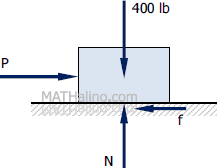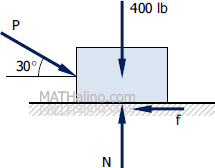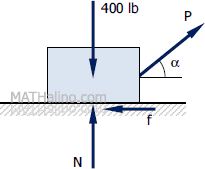Part (a) - Force is applied horizontally

$\Sigma F_V = 0$
$N = 400 \, \text{ lb}$
$f = \mu N = 0.40(400)$
$f = 160 \, \text{ lb}$
$\Sigma F_H = 0$
$P = f$
$P = 160 \, \text{ lb}$ answer
Part (b) - Downward force at 30° from the horizontal
 $\Sigma F_V = 0$
$\Sigma F_V = 0$
$N = 400 + P \sin 30^\circ$
$N = 400 + 0.5P$
$f = \mu N = 0.40(400 + 0.5P)$
$f = 160 + 0.2P$
$\Sigma F_H = 0$
$P \cos 30^\circ = f$
$P \cos 30^\circ = 160 + 0.2P$
$0.666P = 160$
$P = 240.23 \, \text{ lb}$ answer
Another Solution for Part (b)
$\tan \phi = \mu$
$\tan \phi = 0.40$
$\phi = 21.80^\circ$
$\theta = 90^\circ - (30^\circ + \phi)$
$\theta = 90^\circ - (30^\circ + 21.80^\circ)$
$\theta = 38.20^\circ$
$\dfrac{P}{\sin \phi} = \dfrac{400}{\sin \theta}$
$\dfrac{P}{\sin 21.80^\circ} = \dfrac{400}{\sin 38.20^\circ}$
$P = 240.21 \, \text{ lb}$ okay!
Part (c) - Minimum force required to cause impending motion
 $\Sigma F_V = 0$
$\Sigma F_V = 0$
$N = 400 - P \sin \alpha$
$f = \mu N = 0.40(400 - P \sin \alpha)$
$f = 160 - 0.40P \sin \alpha$
$\Sigma F_H = 0$
$P \cos \alpha = f$
$P \cos \alpha = 160 - 0.40P \sin \alpha$
$P \cos \alpha + 0.40P \sin \alpha = 160$
$(\cos \alpha + 0.40 \sin \alpha)P = 160$
$P = \dfrac{160}{\cos \alpha + 0.40 \sin \alpha}$
To minimize P, differentiate then equate to zero
$\dfrac{dP}{d\alpha} = \dfrac{-160(-\sin \alpha + 0.40 \cos \alpha)}{(\cos \alpha + 0.40 \sin \alpha)^2} = 0$
$\sin \alpha - 0.40 \cos \alpha = 0$
$\sin \alpha = 0.40 \cos \alpha$
$\tan \alpha = 0.40$
$\alpha = 21.80^\circ$
Minimum value of P
$P_{min} = \dfrac{160}{\cos 21.80^\circ + 0.40 \sin 21.80^\circ}$
$P_{min} = 148.56 \, \text{ lb}$ answer
